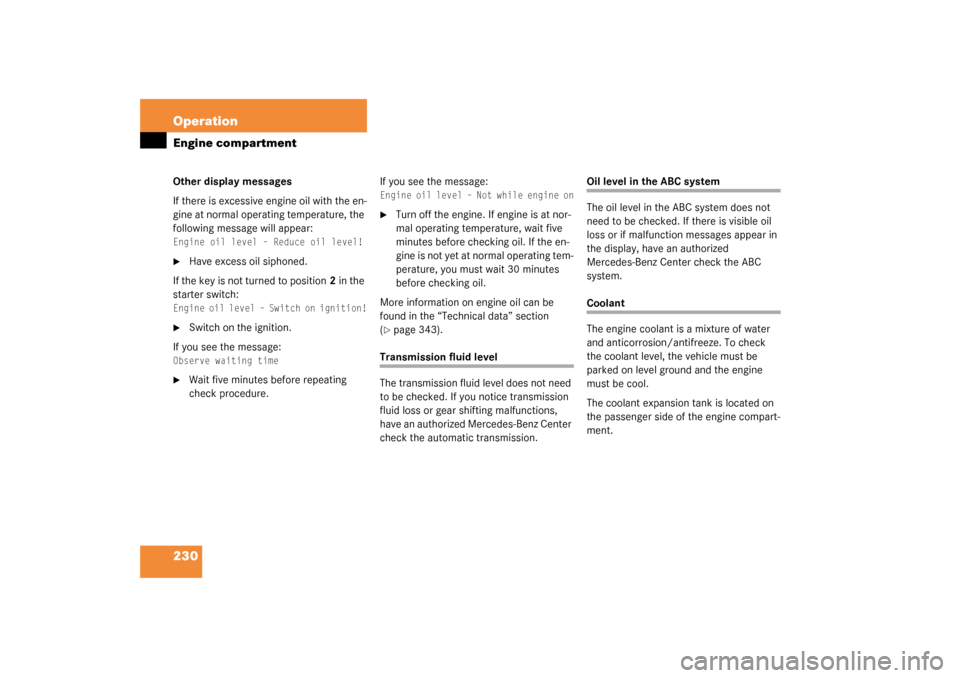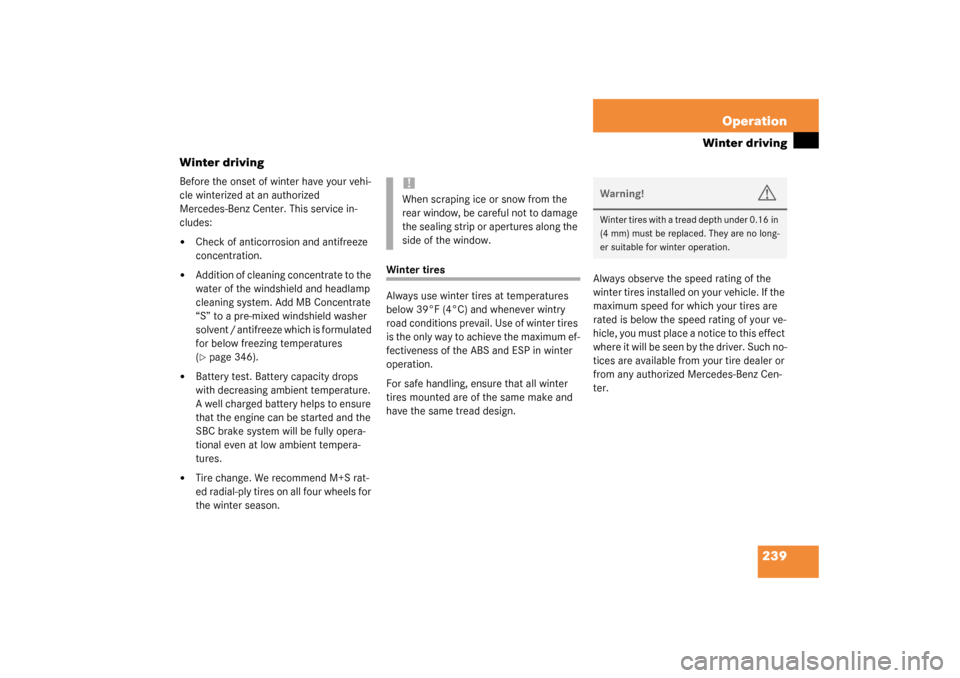Page 227 of 376
227 Operation
Engine compartment
Engine compartment
Hood
Opening
1Hood release
�
Pull lever1 downwards.
The hood is unlocked.
2Lever for opening the hood
�
Push lever2 on the hood upwards.
�
Pull up on the hood and then release it.
The hood will be automatically held
open at shoulder height by gas-filled
struts.
Warning!
G
Do not pull the release lever while the vehi-
cle is in motion. Otherwise the hood could
be forced open by passing air flow.
!To avoid damage to the windshield wip-
ers or hood, never open the hood if the
wiper arms are folded forward away
from the windshield.
Warning!
G
To help prevent personal injury, stay clear of
moving parts when the hood is open and the
engine is running. Make sure the hood is
properly closed before driving. When closing
the hood, use extreme caution not to catch
hands or fingers.
The radiator fan may continue to run for ap-
proximately 30 seconds or may even restart
after the engine has been turned off. Stay
clear of fan blades.
Page 228 of 376

228 OperationEngine compartment
Closing�
Let the hood drop from a height of ap-
proximately 1
1/2ft (50 cm).
The hood will lock audibly.
�
Check to make sure that the hood is
fully closed.
If you can raise the hood at a point
above the headlamps, then it is not
properly closed. Open it again and let it
drop with somewhat greater force.
Engine oil
The amount of oil your engine needs will
depend on a number of factors, including
driving style. Higher oil consumption can
occur when �
the vehicle is new
�
the vehicle is driven frequently at high-
er engine speeds
Engine oil consumption checks should only
be made after the vehicle break-in period.
Checking engine oil level
When checking the oil level the vehicle
must
�
be parked on level ground
�
be at normal operating temperature
�
have been stationary for at least five
minutes with the engine turned off
Warning!
G
If you see flames or smoke coming from the
engine compartment, or if the coolant tem-
perature gauge indicates that the engine is
overheated, do not open the hood. Move
away from the vehicle and do not open the
hood until the engine has cooled. If neces-
sary, call the fire department.Warning!
G
The engine is equipped with a transistorized
ignition system. Because of the high voltage
it is dangerous to touch any components (ig-
nition coils, spark plug sockets, diagnostic
socket) of the ignition system�
with the engine running
�
while starting the engine
�
if ignition is “on” and the engine is
turned manually
Warning!
G
Be careful that you do not close the hood on
anyone.
Page 229 of 376

229 Operation
Engine compartment
You can check the engine oil level on the
multifunction display.�
Turn the key in the starter switch to
position2.
The standard display (
�page 110) should
appear in the multifunction display fields.
�
Press button
k
or
j
on the
steering wheel until the following mes-
sage is seen in the right display field:
Measurement correct only if veh.
levelAfter about three seconds this mes-
sage is displayed:
Engine oil level –
Measuring now!
One of the following messages will sub-
sequently appear in the indicator:�
Engine oil level OK
�
Engine oil add 1.0 qt (1.0 li-
ter)!
�
Engine oil add 1.5 qt (1.5 li-
ters)!
�
Engine oil add 2.0 qt (2.0 li-
ters)!
Adding engine oil
1Filler neck
�
Unscrew the cap from the filler neck1.
Be careful not to overfill with oil.
Be careful not to spill any oil when adding.
Avoid environmental damage caused by oil
entering the ground or water.
�
Screw the cap back on the filler neck. !Excessive oil must be siphoned or
drained off. It could cause damage to
the engine and catalytic converter not
covered by the Mercedes-Benz Limited
Warranty.
Page 230 of 376

230 OperationEngine compartmentOther display messages
If there is excessive engine oil with the en-
gine at normal operating temperature, the
following message will appear: Engine oil level – Reduce oil level!�
Have excess oil siphoned.
If the key is not turned to position2 in the
starter switch:
Engine oil level – Switch on ignition!�
Switch on the ignition.
If you see the message:
Observe waiting time�
Wait five minutes before repeating
check procedure. If you see the message:
Engine oil level – Not while engine on�
Turn off the engine. If engine is at nor-
mal operating temperature, wait five
minutes before checking oil. If the en-
gine is not yet at normal operating tem-
perature, you must wait 30 minutes
before checking oil.
More information on engine oil can be
found in the “Technical data” section
(
�page 343).
Transmission fluid level
The transmission fluid level does not need
to be checked. If you notice transmission
fluid loss or gear shifting malfunctions,
have an authorized Mercedes-Benz Center
check the automatic transmission.
Oil level in the ABC system
The oil level in the ABC system does not
need to be checked. If there is visible oil
loss or if malfunction messages appear in
the display, have an authorized
Mercedes-Benz Center check the ABC
system.Coolant
The engine coolant is a mixture of water
and anticorrosion/antifreeze. To check
the coolant level, the vehicle must be
parked on level ground and the engine
must be cool.
The coolant expansion tank is located on
the passenger side of the engine compart-
ment.
Page 232 of 376

232 OperationEngine compartmentBattery
Your vehicle is equipped with two batter-
ies:�
The starter battery (located in the en-
gine compartment)
�
The battery for electrical consumers
(located in the trunk)
These batteries should always be suffi-
ciently charged in order to achieve their
rated service life.
If you use your vehicle mostly for short dis-
tance trips, you will need to have the bat-
tery charge checked more frequently.
When replacing batteries, always use bat-
teries approved by Mercedes-Benz. If you do not intend to operate your vehicle
for an extended period of time, consult an
authorized Mercedes-Benz Center about
steps you need to observe.
Batteries contain materials that can harm
the environment if disposed of improperly.
Recycling of batteries is the preferred
method of disposal. Many states require
sellers of batteries to accept old batteries
for recycling.
G
Observe all safety instructions
and precautions when han-
dling automotive batteries.
A
Risk of explosion
D
Keep flames or sparks away
from battery. Do not smoke.
B
Battery acid is caustic. Do not
allow it to come into contact
with skin, eyes or clothing.
In case it does, immediately
flush affected area with clear
water and seek medical help if
necessary.
E
Wear eye protection.
C
Keep children away.
F
Follow the instructions in this
Operator's Manual.
Page 239 of 376

239 Operation
Winter driving
Winter driving
Before the onset of winter have your vehi-
cle winterized at an authorized
Mercedes-Benz Center. This service in-
cludes:�
Check of anticorrosion and antifreeze
concentration.
�
Addition of cleaning concentrate to the
water of the windshield and headlamp
cleaning system. Add MB Concentrate
“S” to a pre-mixed windshield washer
solvent / antifreeze which is formulated
for below freezing temperatures
(�page 346).
�
Battery test. Battery capacity drops
with decreasing ambient temperature.
A well charged battery helps to ensure
that the engine can be started and the
SBC brake system will be fully opera-
tional even at low ambient tempera-
tures.
�
Tire change. We recommend M+S rat-
ed radial-ply tires on all four wheels for
the winter season.
Winter tires
Always use winter tires at temperatures
below 39°F (4°C) and whenever wintry
road conditions prevail. Use of winter tires
is the only way to achieve the maximum ef-
fectiveness of the ABS and ESP in winter
operation.
For safe handling, ensure that all winter
tires mounted are of the same make and
have the same tread design. Always observe the speed rating of the
winter tires installed on your vehicle. If the
maximum speed for which your tires are
rated is below the speed rating of your ve-
hicle, you must place a notice to this effect
where it will be seen by the driver. Such no-
tices are available from your tire dealer or
from any authorized Mercedes-Benz Cen-
ter.
!When scraping ice or snow from the
rear window, be careful not to damage
the sealing strip or apertures along the
side of the window.
Warning!
G
Winter tires with a tread depth under 0.16 in
(4 mm) must be replaced. They are no long-
er suitable for winter operation.
Page 246 of 376

246 OperationVehicle careCleaning the Distronic* system sensor
cover
Distronic* system sensor cover
Use a mild car wash detergent, such as
Mercedes-Benz approved Car Shampoo,
with plenty of water to clean the sensor
cover1.
To prevent scratches, never apply strong
force and only use a soft, non-scratchy
cloth when cleaning the sensor. Do not at-
tempt to wipe dirty sensors with a dry cloth
or sponge.Cleaning the Parktronic* system
sensors
1Parktronic* sensors
Use a mild car wash detergent, such as
Mercedes-Benz approved Car Shampoo,
with plenty of water.
When using a steam cleaner or power
washer, aim nozzle only briefly from a min-
imum distance of 4 in. (10 cm) at
sensors1.To prevent scratches, never apply strong
force and only use a soft, non-scratchy
cloth when cleaning the sensors. Do not
attempt to wipe dirty sensors with a dry
cloth or sponge.
Wiper blades
Position of wiper blades when cleaning�
Turn key in the starter switch to
position1.
iRestart the engine after cleaning the
sensor1.
!To prevent damage to the hood or the
wipers, the wiper arms MUST BE folded
forward in the position shown above.
Page 256 of 376

256 Practical hintsWhat to do if …Problem
Possible cause
Suggested solution
?
The yellow CHECK ENGINE mal-
function indicator lamp comes
on while driving.
There is a malfunction in:�
The fuel injection system
�
The ignition system
�
The emission control system
�
Systems which effect emissions
Such malfunctions may result in excessive
emissions values and may switch the engine
to its limp-home (emergency operation)
mode.
�
Have the vehicle checked as soon as
possible by an authorized
Mercedes-Benz Center.
An on-board diagnostic connector is
used by the service station to link the
vehicle to the shop diagnostics sys-
tem. It allows the accurate identifica-
tion of system malfunctions through
the readout of diagnostic trouble
codes. It is located in the front left
area of the footwell next to the park-
ing brake.
The fuel cap is not closed tightly.
�
Check the fuel cap.
Your gas tank is empty.
�
After refuelling, start the engine three
or four times in succession.
The limp-home mode is canceled. You
do not need to have your vehicle
checked.
<
The red seat belt warning lamp
lights up after starting the en-
gine.
The warning lamp reminds you to fasten seat
belts.
�
Fasten your seat belt.